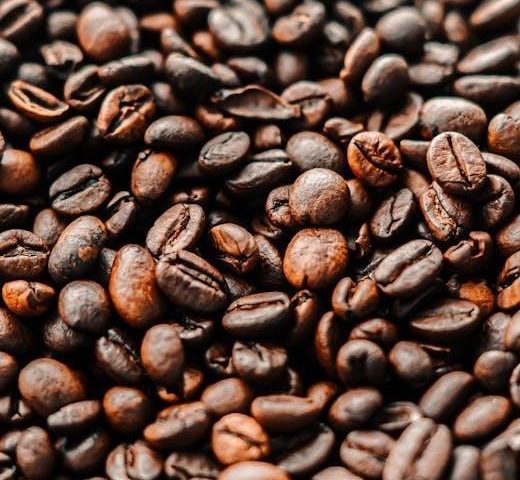2,4-D is a selective herbicide for broadleaf weeds, requiring precise mixing for effective control. Proper dilution ensures target plant damage while keeping grass safe. Follow label instructions for optimal results and environmental safety, typically covering 400-1,000 square feet per gallon.
What is 2,4-D and Its Purpose
2,4-D (2,4-Dichlorophenoxyacetic acid) is a widely used selective herbicide designed to control broadleaf weeds. It works as an auxin mimetic, disrupting plant growth by causing uncontrolled cell division in water and nutrient-carrying tissues. This action leads to the eventual death of the targeted weeds. Common weeds treated with 2,4-D include dandelions, clover, thistle, and bindweed. It is particularly effective on lawns, pastures, and range lands, where broadleaf weeds compete with desirable grasses. The herbicide is available in various formulations, including liquid concentrates, ready-to-use solutions, and granules, making it versatile for different applications. Proper use of 2,4-D ensures effective weed control while minimizing harm to grass and other non-target plants. However, it is essential to follow label instructions carefully to avoid over-application, which can harm the environment or desirable vegetation. 2,4-D is a cost-effective solution for maintaining healthy lawns and agricultural areas by selectively targeting unwanted broadleaf species.

Why Proper Mixing is Essential
Proper mixing of 2,4-D weed killer is critical for effective weed control and safety. Incorrect dilution can lead to under-application, reducing herbicide efficacy, or over-application, which may harm grass, plants, and the environment. Using the right ratio ensures targeted weeds are eliminated without damaging desirable vegetation. Proper mixing also prevents runoff and leaching into soil and water, minimizing ecological impact. Following label guidelines ensures the herbicide adheres to plant surfaces effectively, optimizing results. Deviating from recommended ratios can result in repeated applications, increasing costs and environmental risks. Accurate mixing is vital for maintaining lawn health and achieving long-term weed management. Always consult the product label for specific instructions to ensure safe and effective use of 2,4-D herbicide.
Mixing Instructions for 2,4-D Weed Killer
Properly mix 2,4-D by following the manufacturer’s label for precise ratios. Typically, mix 2.5 oz of herbicide per gallon of water for 400-1,000 square feet. Adjust based on area size and weed severity for effective control and safety.

General Mixing Ratios
The standard mixing ratio for 2,4-D weed killer is typically 2.5 ounces of herbicide per 1 gallon of water, covering approximately 400 square feet. However, ratios may vary depending on the product’s concentration and the severity of the weed infestation. For larger areas, the ratio can be adjusted while maintaining the same concentration. For example, 4 tablespoons (2 ounces) in 2 gallons of water treats 2,000 square feet, while 6 tablespoons (3 ounces) in 3 gallons covers 3,000 square feet. Always refer to the product label for specific guidance, as some formulations may require different measurements. Proper mixing ensures effective weed control without damaging desirable plants. Over-application can harm grass and soil, so precise measurement is crucial. For spot treatments, a smaller ratio, such as 1 tablespoon per 1/2 gallon of water, is often sufficient. Adjustments may also be needed for pastures or range lands, where rates can range from 3 to 4 ounces per 1,000 square feet. Consistency in mixing is key to achieving optimal results safely and efficiently.
Product-Specific Mixing Instructions
Different brands of 2,4-D herbicides may have varying mixing instructions based on their formulation and concentration. For example, Hi-Yield 2,4-D Selective Weed Killer recommends mixing 4 ounces of product per gallon of water to treat 1,000 square feet. Gordon’s Amine 400, on the other hand, suggests 1.1 fluid ounces per gallon for lawns and 1 fluid ounce per gallon for spot treatments. Always refer to the specific product label for guidance, as these ratios can vary significantly. Some products, like those designed for pastures or range land, may require 3 to 4 ounces per 1,000 square feet, mixed in 1 to 3 gallons of water. Others may specify different ratios for preplant applications or large-scale agricultural use. It’s important to note that some formulations may require additional surfactants or adjuvants for optimal performance. Following the manufacturer’s instructions ensures both effectiveness and safety, preventing potential harm to desirable plants or soil. Proper adherence to product-specific guidelines is essential for achieving the best results.
Adjusting the Ratio Based on Area

The mixing ratio of 2,4-D herbicide must be adjusted according to the size of the area being treated. For smaller areas, such as spot treatments, a lower concentration may suffice. For example, mixing 1 tablespoon of 2,4-D per half gallon of water can effectively cover small targeted zones. As the area increases, so does the required amount of herbicide and water. For larger areas, such as lawns or pastures, the ratio is scaled up. For instance, to treat 1,000 square feet, mix 2.5 ounces (5 tablespoons) of 2,4-D with 1 gallon of water. For 2,000 square feet, increase to 4 ounces (8 tablespoons) in 2 gallons of water, and for 3,000 square feet, use 6 ounces (12 tablespoons) in 3 gallons of water. Always ensure the solution is well-mixed and applied evenly to avoid under or over-application. Proper adjustment based on area ensures efficient weed control while minimizing waste and potential environmental impact.

Application Methods and Safety
Apply 2,4-D during midday when weeds are active, avoiding rain or wind. Keep people and pets off treated areas until dry. Follow label instructions and wear protective gear to ensure safe and effective application.

How to Apply 2,4-D Effectively
For optimal results, apply 2,4-D during midday when broadleaf weeds are actively growing, ideally in spring or fall. Ensure the lawn is dry and avoid application if rain is expected within 24 hours. Do not mow the lawn immediately before or after treatment to allow the herbicide to work effectively. Wear protective gear, including gloves, long sleeves, and eye protection, and keep pets and children away until the spray has dried. Follow the recommended mixing ratio on the product label to avoid over- or under-application. Apply the herbicide evenly, using a surfactant if advised by the manufacturer to enhance effectiveness. Allow 7 to 14 days for visible results, and wait at least 30 days before reapplying to prevent lawn damage. Proper timing and precautions ensure safe and effective weed control while protecting the lawn and environment.

Safety Precautions When Handling 2,4-D
Handling 2,4-D requires strict adherence to safety guidelines to minimize risks to people, pets, and the environment. Always wear protective gear, including gloves, long sleeves, and eye protection, when mixing or applying the herbicide. Avoid inhaling the spray mist and ensure the area is well-ventilated. Keep children and pets away from the treated area until the spray has completely dried. Do not allow people or animals to enter the treated area during application. After use, wash hands thoroughly with soap and water, and clean any contaminated clothing separately. Follow all local and state regulations regarding pesticide drift and environmental protection. Store the product in its original container, out of reach of children and pets, and dispose of any leftover mixture and empty containers according to local waste disposal guidelines. Never use 2,4-D near water sources or in areas where it might contaminate waterways. Proper storage and disposal are crucial to prevent accidental exposure and environmental harm. Always refer to the product label for specific safety instructions and precautions.


